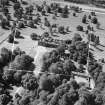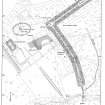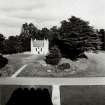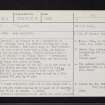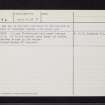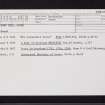Scone Palace, Moot Hill
Abbey (Medieval), Archaeological Feature(S) (Period Unknown), Architectural Fragment(S) (Medieval), Court Hill (Medieval), Ditch (Medieval), Inhumation(S) (Period Unknown), Moot Hill (Medieval), Animal Remains (Period Unassigned), Coin(S) (Medieval), Organic Material(S) (Charcoal)(Period Unassigned), Pin (13th Century), Unidentified Pottery(S) (Medieval)
Site Name Scone Palace, Moot Hill
Classification Abbey (Medieval), Archaeological Feature(S) (Period Unknown), Architectural Fragment(S) (Medieval), Court Hill (Medieval), Ditch (Medieval), Inhumation(S) (Period Unknown), Moot Hill (Medieval), Animal Remains (Period Unassigned), Coin(S) (Medieval), Organic Material(S) (Charcoal)(Period Unassigned), Pin (13th Century), Unidentified Pottery(S) (Medieval)
Alternative Name(s) Boot Hill
Canmore ID 28191
Site Number NO12NW 9.02
NGR NO 11448 26643
Datum OSGB36 - NGR
Permalink http://canmore.org.uk/site/28191
- Council Perth And Kinross
- Parish Scone
- Former Region Tayside
- Former District Perth And Kinross
- Former County Perthshire
NO12NW 9.2 11448 26643
(NO 1145 2665) Boot Hill (NR)
OS 6"map, (1938)
For Mote Church (Stormont Mausoleum), see NO12NW 9.13.
"Boothill" is thought to be a corruption of 'Moothill' although there are several far-fetched tales to support the former. The Gaelic name is 'Tom-a-mhoid'. The hill is also said to have been called, at various times and for various reasons, 'Collis Credulitatis' - 'the Hill of Belief' - and 'Omnis Terra' - 'Everyman's Land,' - and to have been been connected with the coronation ceremonies which took place at Scone. The first mention of the hill is in the reign of Kenneth the Second who from thence is said to have promulgated the celebrated MacAlpin Laws about 850 (J Logan 1886). The hill is said to have been topped by a flat area measuring 100 yards by 60 yards. New Statistical Account (NSA, written by Rev J Craik 1844) 1845; J Logan 1886; S Cowan 1904.
'A large artificial knoll of an oval shape with a level top and its sides sloping at an angle of 20 degrees.
It is about 18ft in height. A church (Perth 86SW), of which the aisle remains, stood on the top of the hill and close to its remains is a small pond or reservoir formed a few years ago.'
Name Book 1864.
Field Visit (16 October 1963)
NO 1143 2663. A large flat-topped oval mound average height 2.0 m. It is now covered with trees and bushes and a mausoleum stands in its centre.
Visited by OS (WDJ) 16 October 1963.
Measured Survey (5 September 1989)
RCAHMS surveyed Moot Hill (NO12NW 9.2 and 9.13) on 5 September 1989 with plane-table and self-reducing alidade at a scale of 1:500. The resultant plan was redrawn in ink.
Field Visit (March 1990)
The origin and nature of the Boot (or Moot) Hill at Scone is unclear, but it may be no more than a scarped natural mound; it is now surmounted by the Mote Church and Stormont Mausoleum (NO12NW 9.13). It has been suggested that it be identified as the castellum Credi which is mentioned in the Annals of Tigernach as the site of a battle between Pictish factions in 728. There is no evidence of any defensive structure on the Moot Hill and the attribution is perhaps unlikely, but there can be little doubt that the Moot Hill was the meeting-place, probably in 906, between Constantine II and Bishop Cellach 'in colle Credulitatis prope regalie civitati Scoan', at which date Scone is clearly recognised as the chief royal centre of the Kingdom.
Already by the 9th century, the hill may have become a symbolic sacred spot as its use as a ceremonial mount for the inauguration of several of the Scottish Kings, and as a place specifically resorted to for royal assembly, is documented in historical and later sources. In origin, the hill perhaps fulfilled the role of a folk-moot, a place of popular assembly, or court, as defined by Barrow and Alcock.
In an 11th-century source it is recorded that Kenneth, son of Alpin (about 848), 'was the first King from among the Gaels that assumed the Kingdom of Scone'. This has been taken to suggest that Kenneth secured Scone as his dynastic seat but need not exclude the possibility that Scone was an earlier Pictish centre of some significance.
Visited by RCAHMS (IMS) March 1990.
Reg Reg Scot; A O Anderson 1922; M O Anderson 1980; G W S Barrow 1981; L Alcock 1988.
Project (2005 - July 2007)
NO 1144 2664 (Moothill), NO 1145 2654 (Scone Abbey) The Moothill and Abbey of Scone Survey Project (MASS Project) undertook a first season of geophysical surveys in the grounds of Scone Palace, aimed at locating the remains of Scone Abbey and investigating the interior and surroundings of the Moothill mound. Survey was targeted on the basis of the findings of a pilot project carried out in 2005 as part of the author’s PhD thesis. In 2005 fluxgate gradiometer and resistivity survey were used, which identified multiple anomalies indicative of structural remains in the area of lawns SE of Scone Palace. These were not sufficiently resolved to allow detailed interpretation but were provisionally interpreted as remains of Scone Abbey based on their size and general alignment. Subsequently the MASS Project was formed to expand upon these findings and develop a
research framework for archaeological remains in Scone Palace grounds with the aim of increasing knowledge about the royal medieval centre and monastic church of Scone.
Geophysical survey was carried out over two weeks in July 2007. Ground penetrating radar (0.56ha) was used to produce a timeslice across key target areas identified during 2005. Fluxgate-gradiometer (1.44ha) and resistivity (0.5ha) survey were also undertaken in an expanded survey area, using a higher resolution sampling strategy than in 2005. The 2007 survey has produced convincing evidence indicating the location and partial
layout of the Augustinian abbey church and other elements of the monastic cloister. This was in the upper half of a landscaped slope which descends toward the SE from the lawns S of the Moothill and adjacent to Scone Palace. The radar results were particularly clear and corroborated the magnetic and resistance results. At approximately 1.53m deep in the radar timeslice on the lawns and slope structural remains of the abbey church were encountered. Based on the coherent plan represented by these anomalies it has proved possible to identify a 64m-long section of the abbey church, including the site of the church crossing piers, a substantial section of the E limb, the floor plan of the N transept, the E portion of the nave and the fragmentary outline of the S transept. The line of the N and S aisle arcades were also identified. Furthermore, individual buttress features were visible on the N wall.
The majority of these results are likely to represent the latest medieval structural phase of the abbey, most probably constructed during the 12th and 13th centuries. The resistivity and radar results suggest that most of the abbey’s remains survive as back-filled robber trenches. A square anomaly measuring 8 x 8m was encountered adjoining the eastern end of the church’s southern wall, and based on analogy with Arbroath and Pluscarden this may represent the site of the sacristy. Moreover, evidence for a potentially earlier phase of
construction was indicated by a linear anomaly running down the centre of the abbey church on a slightly different alignment.
Adjoining the S of the nave and site of the S transept were less clearly resolved anomalies which are interpreted as elements of the monastic cloisters. These may include fragments of the cloister alleys, the E range, and the N wall of the S range. Significantly, the anomalies associated with the cloisters were
encountered at a greater depth than those relating to the abbey church, suggesting that the monastic range was built upon a lower terrace. The results indicate a substantial depth of material overlying the cloister anomalies, which is interpreted as dumped material used to construct the post-medieval landscaped slope
that constitutes the current ground surface.
A concentration of globular anomalies to the N of the abbey church may represent the location of burials, and in this vicinity during the 19th and 20th centuries human remains were discovered. This is perhaps surprising given that the monastic cemetery would normally be expected E of the E range, and this may indeed be indicated by the site of a post-medieval cemetery. Fluxgate-gradiometer survey further to the S and E of the abbey church also indicated a prominent linear anomaly aligned S–W to N–E. This may indicate the line of the monastic main drain in the lawns S of a post-medieval walled cemetery and landscaped slope, or perhaps the path of an enclosure shown in the vicinity on a 1797 map of the estate. Also, prominent areas of magnetic disturbance and minor linear anomalies may indicate post-medieval garden features and drainage.
NO 1144 2664 Radar survey was undertaken on the S–W area of the Moothill’s summit in an L-shaped grid consisting of three 20 x 20m grids around the southern corner of the Moothill chapel. This produced a timeslice which showed at approximately 0.3m depth a rectilinear anomaly measuring 20m E to W and 10m N to S. This may represent the remains of a 17th-century parish church known to have been situated on the mound. The location of the Moothill chapel is thought to correlate with the site of the northern aisle of the 17th century parish church and this appears to be supported by the geophysical results. Closely aligned with the rectilinear anomaly were two linear anomalies which form a right-angle, and these may indicate the location of an enclosure around the parish church. The resistivity and magnetic surveys helped to support these findings. The site of an ornamental pond on the summit was confirmed to the W of the Moothill chapel, and based on
the magnetic results this may be partially composed of fired brickwork. A further linear anomaly was encountered at a lower level to the S of the Moothill chapel and this may represent a feature which pre-dates the 17th century church, although further interpretation is not possible at this stage.
A timeslice survey was also recorded at the base of the Moothill on the SE side. This encountered the line of a modern pipeline overlying a large homogeneous response located around the Moothill’s base and partly underlain by the body of the mound. The resistivity and magnetic surveys appear to support these findings. This is interpreted as a section of a ditch associated with the Moothill, over which mound material may have subsequently slumped or been redeposited. A further eight radar profiles were carried out across the body of the mound. Evidence for the continuation of the possible ditch was encountered on the N and S sides of the mound. Also indicated were the paths of modern service pipelines adjacent to the base of the mound to the N and S. The interior of the Moothill produced a series of interesting radar reflections. Some of these may relate to later activity such as the construction of an ornamental pond, but others may possibly derive from earlier archaeological remains. The interpretation of these features is in progress.
Archive to be deposited with RCAHMS.
Funder: Society of Antiquaries of Scotland, Hunter Marshall Trust, Russell Trust, Perth and Kinross Heritage Trust, University of Glasgow.
Ground Penetrating Radar (2005 - July 2007)
NO 1144 2664 (Moothill), NO 1145 2654 (Scone Abbey) Ground penetrating radar survey.
Archive to be deposited with RCAHMS.
Funder: Society of Antiquaries of Scotland, Hunter Marshall Trust, Russell Trust, Perth and Kinross Heritage Trust, University of Glasgow.
Earth Resistance Survey (2005 - July 2007)
NO 1144 2664 (Moothill), NO 1145 2654 (Scone Abbey) Resistivity survey.
Archive to be deposited with RCAHMS.
Funder: Society of Antiquaries of Scotland, Hunter Marshall Trust, Russell Trust, Perth and Kinross Heritage Trust, University of Glasgow.
Magnetometry (2005 - July 2007)
NO 1144 2664 (Moothill), NO 1145 2654 (Scone Abbey) Magnetometry survey.
Archive to be deposited with RCAHMS.
Funder: Society of Antiquaries of Scotland, Hunter Marshall Trust, Russell Trust, Perth and Kinross Heritage Trust, University of Glasgow.
Excavation (July 2008 - August 2009)
NO 11448 26643 Trial trenching was undertaken in the grounds of Scone Palace on the site of Scone Abbey and
Moothill mound in two seasons in July 2008 and August 2009. Trenches were targeted on the basis of findings from geophysical surveys undertaken during 2005 and 2007 (see DES 2007). An additional geophysical survey was completed over the site of the abbey and neighbouring medieval village of Scone during 2008. Ground-penetrating radar identified the site of the S and W range of the abbey cloister. On the site of the abbey, trenches were opened over the N wall of the N transept, the N aisle arcade in the E limb of the abbey church, the W crossing piers, the S wall of the nave, the presumed site of the S transept and chapter house, and the N
wall of the refectory. The six trial trenches measured 2 x 4m, though small extensions were completed where necessary. Most of the abbey walls had been removed during post-reformation robbing, as had been expected from the geophysics results of previous seasons. Only occasional fragments of in situ foundations were encountered, including the remains of a buttress on the N wall of the N transept, which was specifically targeted by the geophysics. The depth and survival of archaeological deposits decreased from the northern top of a landscaped slope beside Scone Palace, beneath which the abbey remains have been concealed by
post-medieval landscaping. The preservation of the abbey church’s remains was notably better than that of the cloister and monastic buildings. Substantial foundations were located at the site of the church crossing. These consisted of undressed sandstone boulders bonded with mortar. A minor slot was placed through these foundations to investigate a linear geophysical anomaly that ran down the middle of the abbey church. Large dressed stones were uncovered beneath the crossing foundations that formed the fill of a feature extending beneath the W and E baulks. This may be the robbed remains of a wall from an earlier church. The site of the S wall of the abbey church’s nave and N wall of the N transept were represented by large backfilled robber-trenches. In situ inhumations were encountered close by the site of the church walls, within the church and
on the exterior of the N transept. A fine medieval dress-pin, provisionally dated to the 13th century, was found in
redeposited soils used for post-medieval landscaping over the abbey church nave. Two unstratified late medieval coins were also discovered on the site of the abbey church. Very few remains of the S transept or chapter house were found. In contrast, a substantial robber trench was discovered at the site of the refectory N wall. From the slot across this feature, multiple fragments of fine ornamented medieval masonry were recovered, including examples of 13th-century stiff leaf design in red sandstone, probably from column capitals.
At the Moothill two trial trenches were excavated, one at the northern base and the other at the SE base of the mound. These measured 12 x 4m and 15 x 2m respectively. The trenches were located to investigate the line of a geophysical anomaly interpreted as a large in-filled ditch. The N trench recorded substantial quantities of redeposited natural sand and sandstone rubble used for landscaping. Numerous tree boles indicated post-medieval plantations in the estate gardens. Underlying this was a deep deposit of loamy soil containing late medieval pottery within which was a horizon of sandstone rubble including sculptured masonry fragments. This overlay a spread of charcoal above natural sand. Geophysical results indicated that the targeted ditch
feature is located S of a 19th-century water pipe near the base of the Moothill, beyond the area of excavation and in part beneath the N slope of the mound.
The SE Moothill trench was located across a clearly resolved section of the ditch anomaly. A large ditch was found beneath landscaping layers. A 1m wide slot was excavated across the ditch to the bottom of the feature. The ditch measured 8m wide with natural sand at the base, just under 3m below the modern ground surface. On the upper inside slope of the ditch a cut slot feature was found around the historic base of the Moothill. In the base of this were hexagonal stakeholes, interpreted as the remains of a fence or palisade structure
enclosing the mound. This feature had been cut through ditch fills containing medieval pottery. The ditch was
U-shaped in profile and contained multiple sandy fills with variable clay and silt compositions. The lower fills contained dense inclusions of animal bone, charcoal fragments and medieval pottery. Bulk samples of all fills were taken for environmental analysis and radiocarbon dating. Samples were also taken from the section for thermoluminescence dating. Confirmation of the ditch illustrates that the Moothill mound is likely to have been substantially altered and supports the artificial origins of the Moothill. The 2008–09 excavations were aimed at evaluating the archaeological remains; fieldwork for this stage of the project is now complete and post-excavation analysis is underway.
Archive: RCAHMS (intended)
Funder: Hunter Archaeological Trust; Perth and Kinross Heritage Trust; Russell Trust; Society of Antiquaries of London; Society of Antiquaries of Scotland and Strathmartine Trust
Oliver JT O’Grady – Moothill and Abbey of Scone Project
Ground Penetrating Radar (18 July 2023 - 28 July 2023)
NO 11431 26642 AOC Archaeology Group was commissioned by Scone Palace to undertake a Ground Penetrating Radar (GPR) survey. The aim was to locate, record and characterise any potential surviving sub-surface archaeological remains and services within the survey area and to produce a comprehensive site archive and report. A very strong response was detected in the northeast of the walled mound within the stable block courtyard. The strong response suggests a potential void, or structural remains. A broad low amplitude response was detected to the southeast of Moot Hill. This was thought to be associated with the ditch which is known to surround Moot Hill. However, it was not very well-defined. This could be due to lack of contrast, clay content, or subsequent landscaping. Linear zones of high amplitude response were detected immediately to the southeast of the chapel and may represent in-situ foundations of the 17th-century parish church known to have been situated on the mound. Associated with these responses were linear anomalies to the south, north and west. These could indicate further structural remains, or an enclosure associated with the earlier church. However, some may indicate more recent layouts of the area. A clearly defined rectilinear response was detected to the west of the Chapel. The response suggests a possible structure but was noted as unclear in origin as it may have a natural or modern origin. It does appear to be associated with the historic feature believed to be a former pond. Several services and drains were detected within the survey area including the water main running to the south and east of Moot Hill and the fire main which runs to the north of Moot Hill. Additional linear trends indicative of services could be seen to the north and east of the stable block and along the palace frontage
Information from S. Ovenden - AOC Archaeology Group, 2023.
OASIS ID: aocarcha1-518773
Project












